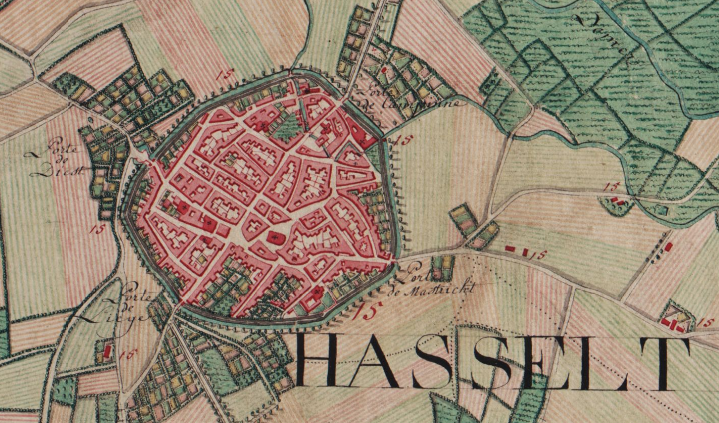|
Alken, Belgium
Alken (; li, Alleke ) is a municipality located in Belgian province of Limburg. The community lies just south of the provincial capital of Hasselt, in the Hesbaye region. Alken has about 11,300 residents, which gives the village a larger population than the nearby small cities of Borgloon and Herk-de-Stad. History Alken appeared for the first time in history in 1066 under the name Alleche. Since 1180, the official name of the municipality is Alken but 'Alleke' is still often used by locals. Alken was an enclave of the Bishopric of Liège surrounded by the county of Loon. Many Prince Bishops had a summer residence here. Village centers The municipality has no districts. But has 3 village centers or major neighborhoods. Alken-Centre, Sint-Joris (St. George) and Terkoest. Alken-Centre is located in the east of the municipality, neighboring Hasselt and Wellen. The parish is dedicated to St. Aldegondis and it is the oldest parish in Alken. The city hall, the CPAS, most shops ... [...More Info...] [...Related Items...] OR: [Wikipedia] [Google] [Baidu] |
Arrondissement Of Tongeren
The Arrondissement of Tongeren ( nl, Arrondissement Tongeren; french: Arrondissement de Tongres) is one of the three administrative arrondissements in the Province of Limburg, Belgium. It is both an administrative and a judicial arrondissement. However, the Judicial Arrondissement of Tongeren comprises the municipalities of Tongeren, Bocholt, Bree, Kinrooi, Meeuwen-Gruitrode, Dilsen-Stokkem and Maaseik in the Arrondissement of Maaseik and the municipalities of As, Genk, Opglabbeek and Zutendaal in the Arrondissement of Hasselt. The arrondissement was created in 1839 to form the Belgian part of the former arrondissement of Maastricht, which ceased to exist due to the splitting of Limburg. The canton of Borgloon was also moved from the arrondissement of Hasselt to the new arrondissement of Tongeren. Municipalities The Administrative Arrondissement of Tongeren consists of the following municipalities: * Alken * Bilzen * Borgloon * Heers * Herstappe * Hoeselt * Kortessem * ... [...More Info...] [...Related Items...] OR: [Wikipedia] [Google] [Baidu] |
Sint-Truiden
Sint-Truiden (; french: link=no, Saint-Trond ; li, Sintruin ) is a city and municipality located in the province of Limburg, Flemish Region, Belgium, and has over 41,500 inhabitants, which makes it one of the largest cities in Limburg. The municipality includes the former communes (now ''deelgemeenten'') of Aalst, Brustem, Duras, Engelmanshoven, Gelinden, Gorsem, Groot-Gelmen, Halmaal, Kerkom-bij-Sint-Truiden, Melveren, Metsteren, Ordingen, Runkelen, Velm, Wilderen, and Zepperen. The city is in the centre of Belgium's fruit-producing region, ''Haspengouw'' (Hesbaye), and is renowned for its pears, apples (Jonagold), and sweet cherries. History Origins and Golden Age The municipality formed around an abbey founded by St. Trudo, a Frankish nobleman, in the 7th century. Legend has it that as a boy, Trudo was playing while building a small church with some rocks. When a woman scornfully kicked over the rocks she was struck by sudden blindness. Trudo cured her from this blindness ... [...More Info...] [...Related Items...] OR: [Wikipedia] [Google] [Baidu] |
Kortessem
Kortessem (; li, Kotsoeve) is a municipality located in the Belgian province of Limburg near Hasselt. On January 1, 2006, Kortessem had a total population of 8,074. The total area is 33.90 km² which gives a population density of 238 inhabitants per km². The municipality consists of the following sub-municipalities: Kortessem, Guigoven, Vliermaal, Vliermaalroot, and Wintershoven. Up until its destruction by a storm in 2009, Kortessem was the home of the ''Onzelievehereboom'': a 1200-year-old oak. Since 16 May 2014 Herman Van Rompuy is an honorary citizen. Since 1990 the most famous party of Vlaanderen, Nacht van de Hoegaarden, was made in Kortessem Gallery File:Dessener1.png, Dessener Castle, former residence of Field Marshal Guillaume de Lamboy, Baron of Cortesheim Guillaume III de Lamboy de Dessener, 1590 to 1659, was a Field Marshal in the Imperial Army, who served in the 1618 to 1648 Thirty Years War, and the 1635 to 1659 Franco-Spanish War. Born in Kortes ... [...More Info...] [...Related Items...] OR: [Wikipedia] [Google] [Baidu] |
Alken-Maes
Alken-Maes is a Belgian brewery created out of the 1988 merger of two small breweries, Maes located at Kontich-Waarloos and Cristal-Alken located at Alken. It was bought by Scottish & Newcastle in 2000, who were taken over by Carlsberg and Heineken in 2007. History Alken-Maes was created out of the 1988 merger of two small breweries, Maes located at Kontich-Waarloos and Cristal-Alken located at Alken. Both had specialized in pils (Maes was producing Maes pils and Alken Cristal pils) until Maes purchased the Union brewery (based in Jumet) in 1978, which produced Grimbergen beer among others. After the merger, the group continued to purchase other breweries to expand their offer to a larger panel of beers. In 1989, the new brewery purchased a 50% stake in De Keersmaeker brewery, which specialized in spontaneous fermentation beers such as Mort Subite. In 2000, it bought Ciney and Brugs Witbier as well as the other 50% of De Keersmaeker. In the same year, the brewery w ... [...More Info...] [...Related Items...] OR: [Wikipedia] [Google] [Baidu] |
Herk (river)
Herk may refer to: Given name *Herk Harvey (1924-1996), American actor *Herk Robinson (born 1941), American front office executive in Major League Baseball Surname *Big Herk (born 1969), pseudonym of Amery Dennard, American rapper *Isidore Herk (1882–1944), American burlesque manager Places * Herk (river), a small river in Belgium, tributary of the Gete *Herk-de-Stad Herk-de-Stad (; french: Herck-la-Ville, ) is a city and municipality located in the Belgian province of Limburg. On 1 January 2018, Herk-de-Stad had a total population of 12,661. The total area is 42.83 km² which gives a population density of ..., a municipality in Limburg, Belgium See also * Van Herk {{disamb, given name, surname ... [...More Info...] [...Related Items...] OR: [Wikipedia] [Google] [Baidu] |
Alken Railway Station
Alken is a railway station in the municipality of Alken, Limburg, Belgium. The station opened on 8 December 1847 and is located on line 21. The train services are operated by National Railway Company of Belgium french: Société nationale des chemins de fer belgesgerman: Nationale Gesellschaft der Belgischen Eisenbahnen , type = Statutory corporation , industry = Rail Transport , foundation = 1926 , founder = Government of ... (NMBS). The first station building opened in 1847. The current building dates from 1903. Train services The station is served by the following services: *Intercity services (IC-03) ''Blankenberge - Bruges - Ghent - Brussels - Leuven - Hasselt - Genk'' References External links * Railway stations in Belgium Railway stations in Limburg (Belgium) Railway stations in Belgium opened in 1847 {{Belgium-railstation-stub ... [...More Info...] [...Related Items...] OR: [Wikipedia] [Google] [Baidu] |
Wellen
Wellen (; li, Wille) is a municipality located in the Belgian province of Limburg. On 1 January 2018, Wellen had a total population of 7,402. The total area is 26.72 km², giving a population density of 266 inhabitants per km2. The municipality consists of the following sub-municipalities: Wellen, Berlingen, Herten and Ulbeek. Other population centres and hamlets include: Bos, Beurs, Kukkelberg, Langenakker, Oetersloven, Overbroek, Russelt, and Vrolingen. History Archaeological findings suggest the place was inhabited already during the Frankish period (5th to 7th century). Debris from the river Herk on that spot made fertile soil for farming. Mention of the name Wellene or Welnis doesn't occur until the second half of the 12th. The name Wellen derives from the Middle Dutch "''wellene''", meaning "source" or "pit" or, alternately, from Latin Latin (, or , ) is a classical language belonging to the Italic branch of the Indo-European languages. Latin was origina ... [...More Info...] [...Related Items...] OR: [Wikipedia] [Google] [Baidu] |
Hasselt
Hasselt (, , ; la, Hasseletum, Hasselatum) is a Belgian city and municipality, and capital and largest city of the province of Limburg in the Flemish Region of Belgium. It is known for its former branding as "the city of taste", as well as its local distelleries of Hasselt jenever (gin), the Hasselt Jenever Festivities, Limburgish pie and the Hasselt speculaas. The municipality includes the original city of Hasselt, plus the boroughs of Sint-Lambrechts-Herk, Wimmertingen, Kermt, Spalbeek, Kuringen, Stokrooie, Stevoort and Runkst, as well as the hamlets and parishes of Kiewit, Godsheide and Rapertingen. On 01 July 2022 Hasselt had a total population of 80,260 (39,288 men and 40,972 women). Both the Demer river and the Albert Canal run through the municipality. Hasselt is located in between the Campine region, north of the Demer river, and the Hesbaye region, to the south. On a larger scale, it is also situated in the Meuse-Rhine Euroregion. History Hasselt was founded in a ... [...More Info...] [...Related Items...] OR: [Wikipedia] [Google] [Baidu] |
New Flemish Alliance
The New Flemish Alliance ( nl, Nieuw-Vlaamse Alliantie, N-VA) is a Flemish nationalist and conservative political party in Belgium. The party was founded in 2001 by the right-leaning fraction of the centrist-nationalist People's Union (VU). The N-VA is a regionalist and separatist movement that self-identifies with the promotion of civic nationalism.Manifesto of the New Flemish Alliance point 13: "Inclusion for newcomers" (in Dutch). It is considered part of the ; the party strives for the peaceful [...More Info...] [...Related Items...] OR: [Wikipedia] [Google] [Baidu] |
Bishopric Of Liège
In church governance, a diocese or bishopric is the ecclesiastical district under the jurisdiction of a bishop. History In the later organization of the Roman Empire, the increasingly subdivided provinces were administratively associated in a larger unit, the diocese (Latin ''dioecesis'', from the Greek term διοίκησις, meaning "administration"). Christianity was given legal status in 313 with the Edict of Milan. Churches began to organize themselves into dioceses based on the civil dioceses, not on the larger regional imperial districts. These dioceses were often smaller than the provinces. Christianity was declared the Empire's official religion by Theodosius I in 380. Constantine I in 318 gave litigants the right to have court cases transferred from the civil courts to the bishops. This situation must have hardly survived Julian, 361–363. Episcopal courts are not heard of again in the East until 398 and in the West in 408. The quality of these courts was l ... [...More Info...] [...Related Items...] OR: [Wikipedia] [Google] [Baidu] |



